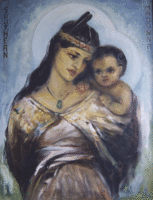Columns
Kieran Fenn fms
November 2012
 The church has stated that there is ‘a hierarchy of truths’ and one could easily get the impression that the Marian dogmas, for better or worse, do not currently have the priority and influence that they used to have. They are often the source of great difficulty with regard to their source – or lack of it! – in scripture, as well as their contemporary relevance.
The church has stated that there is ‘a hierarchy of truths’ and one could easily get the impression that the Marian dogmas, for better or worse, do not currently have the priority and influence that they used to have. They are often the source of great difficulty with regard to their source – or lack of it! – in scripture, as well as their contemporary relevance.
The mysteries of faith as expressed in doctrines and dogmas are historically conditioned, with a meaning not always self-evident. They bear the marks of the philosophical and theological thinking of their own time and may not always be the most suitable for every time and place.
 Historical priorities
Historical priorities
History is a good teacher. Saints Bernard, Thomas Aquinas and Bonaventure – who can hardly be said to be wanting in authentic faith – explicitly rejected the doctrine of the immaculate conception. It was totally unknown to the Church fathers, and in 1644, the Holy Office in Rome forbade the use of the term.
Marian doctrine did not emerge until the third ecumenical council at Ephesus in 431 declared Mary to be ‘theotokos’, the God bearer. The church was busy with other matters and a huge doctrinal development was in progress through five centuries.
The knowledge of the one God was replacing the multitude of gods. The birth, death, and resurrection of Jesus were now the defining points from which the reality of God was affirmed. Trinity and the truths about Jesus Christ had to be in place before those about Mary. The presence of Mary is so interwoven with the gift of Christ himself that they are virtually inseparable.
Distinguishing the universal
Dogma attempts to capture the faith of the community, but God is not confined in any formula which reflects the limitations of its time, language, and thinking. We have to learn to distinguish what has a universal value from what is situated only in the context of its era. The dogma of the immaculate conception reflects a certain view of original sin held around 1854, and thinking has evolved since then. The challenge is how to make dogma speak to the 21st century rather than be confined to formulas that we nod our heads at without understanding them.
Dogma gives the impression of granting certain ‘privileges’ to Mary which has resulted in distancing and isolating her rather than making her more approachable.
What do we know about these beliefs? What are the values and the limits of each dogma? Dogma carries the seal of approval by the Church, manifesting a certain consensus of the faithful.
In our history as Church there are four major affirmations about Mary: ‘Mother of God,’ ‘always a virgin,’ immaculate since her conception’, and ‘fully participating in the resurrection of Christ since the end of her earthly existence (assumption)’. They are not all from the same period of time, nor do they have the same degree of relation to the Bible.
Recent belief?
The dogmatic definition of the immaculate conception and assumption came late in Church history, in the 19th to mid-20th centuries. Behind the definitions lies a long history. And let’s be clear: it is Mary’s conception the dogma speaks of rather than the virginal conception of her son. This all too frequent misunderstanding would be clarified by renaming the dogma as ‘the conception of the immaculate virgin’.
The first questions concerning the immaculate conception of Mary were raised in the middle of the fifth century in discussions on the sanctity of Mary between Augustine, Pelagius, and the cultured Italian bishop, Justin d’Eclane. In the Middle Ages, the great theologians were divided on the question. Thomas Aquinas objected on the grounds that the immaculate conception could be interpreted as Mary being saved independently of Christ, without need of him.
Liturgical feasts
Before Ephesus (431) there had been but one liturgical feast of Mary, the feast of the Purification, celebrated only in certain parts of the Eastern Church. But after Ephesus the feasts began to multiply. From the beginning of the sixth century, various churches celebrated Mary’s bodily assumption into heaven. This was a belief that originated not from biblical evidence or even patristic testimony, but as ‘fitting’. It was fitting that Jesus should rescue his mother from the corruption of the flesh, and so he must have taken her bodily into heaven.
In the East, towards the end of the seventh century, the feast of the Conception of Mary was celebrated under different names: ‘the Announcement of the Holy God-bearer’, the ‘Conception of St Anne’, Anne’s ‘Conception of Mary’. The feast of the Dormition (falling asleep – death) of Mary was celebrated in Jerusalem from the year 500, and a hundred years later in Constantinople by decree of the Emperor.
By the seventh century four separate Marian feasts were observed in Rome: the annunciation, the purification, the assumption, and the nativity of Mary. At the end of the century the feast of the conception of Mary began in the East, but did not enter the West until the 11th century.
Unlike other Marian dogmas, Mary’s divine motherhood has deep and solid scriptural roots. In 25 texts she is referred to as mother, while only two texts call her virgin. Mary’s son, who shares the Father’s divinity from all eternity, begins to exist in her at the moment of incarnation; he is ‘born of a woman’.
Year of Faith
Pope John Paul II called Mary the Star of Evangelization: she was the first to bring Jesus to the world and lived with him the longest of any of his friends, apostles, and disciples. We are celebrating a year of faith, which started in October.
We are not to forget that Mary marks our path as first disciple, model in faith, and the ideal to which the church aspires.
References: Coyle, Kathleen. (1998). Mary in the Christian Tradition. Divine Word; Prevost, Jean-Pierre (1988) Mother of Jesus Novalis.
Image: Southern Madonna by Julia Lynch (Sr Mary Lawrence) from the website of Auckland’s Good Shepherd College.